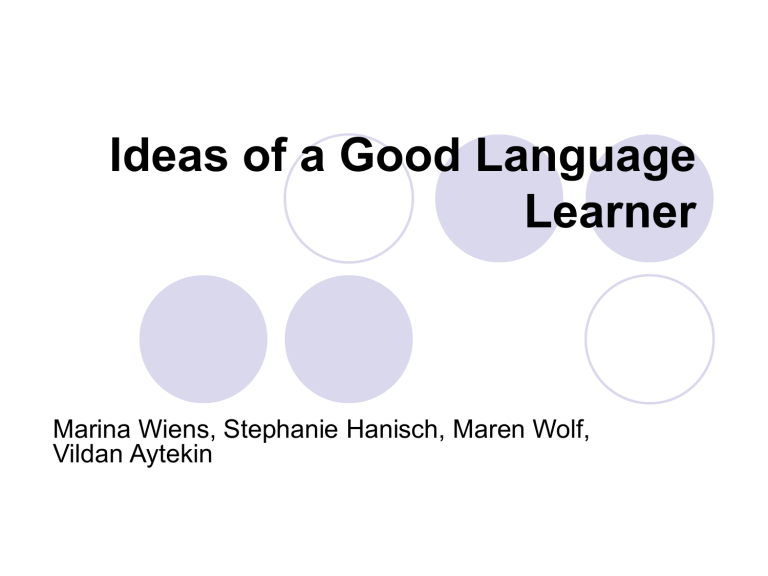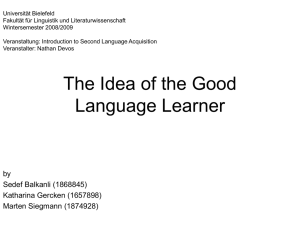Ideas of a Good Language Learner

Ideas of a Good Language
Learner
Marina Wiens, Stephanie Hanisch, Maren Wolf,
Vildan Aytekin
Table of Contents
Introduction
Good language learner characteristics
Research & problems on the topic
Variables
Learning styles & success
Motivation
Learner beliefs
Inhibition and anxiety
Ethnic groups
Dicussion
Who is a ‘good language learner‘?
Intelligent
Able to learn quickly (Aptitude)
Motivation
Age
Outgoing personality
Remaining Issues
How did research identify the personal characteristics that make one learner more successful than another?
To what extent can we predict differences in the success of
SLA if we have information about learners’ personalities
?
Research on Learner characterictics
Select group of learners and give them a questionnaire to measure the type and degree of their motivation.
Some kind of test is used to assess their Language Proficiency.
VARIABLES
scoring (Correlation)
LPT
A good language learner
a b j i h f e c d g l k is a willing and accurate guesser 1 2 3 4 5 tries to get a message across even if specific language knowledge is lacking
1 2 3 4 5 is willing to make mistakes constantly looks for patterns in the language
1 2 3 4 5
1 2 3 4 5 pactises as often as possible 1 2 3 4 5 analyses his or her own speech & the speech of others 1 2 3 4 5 attends to whether his/her performance (..) enjoys grammar exercieses begins learning in childhood has an above-average IQ
1 2 3 4 5
1 2 3 4 5
1 2 3 4 5
1 2 3 4 5 has good academic skills has a good-image and lots of confidence
1 2 3 4 5
1 2 3 4 5
Problems
We can not directly observe and measure variables
Social and educational backgrounds
Characteristics are not independent from each other
successful because of motivation or motivated because of success?
Conclusion
Researches seek to know how different cognitive and personality variables are related and how they interact with learners’ experiences so that they can gain a better understanding of human learning.
Educators hope to help learners with different characteristics achieving success in Second Language
Learning
Intelligence
Traditionally = performance on certain kinds of tests associated with success at school
Link between IQ and L2-learning predicting success
IQ rather related to Metalinguistic knowledge than to communicative ability
IQ influences language analysis and rule learning
Nevertheless students with weak academic performance often succeed in L2-learning
Theory of Multiple Intelligences -
Howard Gardner (1993)
Traditional IQ tests asses only limited range of abilities: verbal intelligence
strength in the language arts: speaking, writing, reading, listening
verbal intelligent pupils most successful because this kind of intelligence lends itself to traditional teaching
Aptitude
Specific abilities predicting success in language learning
John Carroll (1991): aptitude = ability to learn quickly
Hypothesis: learner with high aptitude may learn easier and quicker but others may also succeed if they keep up
Aptitude Tests
M odern L anguage A ptitude T est (MLAT) by Carroll and Sapon 1959
P imsleur L anguage A ptitude B attery
(PLAT) by Pimsleur 1966
Computer tests by Paul Meara 2005
Several Components of Aptitude
Ability to
Identify and memorize new sounds
Understand the function of particular words in sentences
Figure out grammatical rules from language samples
Remember new words
Aptitude Test Results
Positive correlations of performance in
Aptitude Tests and foreign language performance at times of Grammar
Translation and Audiolingual Methods
Communicative Approach common belief: measured abilities irrelevant for LA
Other beliefs: some measured abilities predict success in communicative settings
Other Beliefs
Leila Ranta (2002): good language analytics => most successful in SLL without focus on grammar
Nick Ellis (2001): Working Memory = most important predictive variable
Peter Skehan (1989)
Due to learners’ individual differences of strengths and weaknesses in the components of abilities they succeed in different instructional programmes
Learning Styles
Simlpy put: various approaches or ways of learning
Reid (1995): Learning style = individual’s natural, habitual, and preferred way of absorbing, processing and retaining new information and skills
Perceptually-based learning styles
Visual Learners (Eye)
Aural Learners (Ear)
Kinaesthetic Learners (Physical Action)
Cognitive learning styles
Field dependence (holistic/global thinking)
tendency to see the perceptual field as a whole without analyis of single parts of the field: “seeing the forest for the trees”
learner excels in classroom learning which involves analysis, attention to details, and mastering of exercises, drills, and other focused activities
Field independence (analytical thinking)
tendency to break the field down into its component parts and to seperate details from the general background
learner achieves higher success in everyday language situations beyond the classroom; tasks requiring interpersonal communication skills
Interaction of Learning Styles and
Success in Language Learning
unchangable differences or development through experience?
Insufficient research in this area
a single teaching method will never suit the needs of all types of learners
variation of methods needed to accommodate all types
Motivation and attitudes
Robert Gardner has carried out a program of research on the relationship between a learner's attitudes toward the second or foreign language and its community, and success in second language learning.
But it is difficult to know whether positive attitudes produce successful learning or successful learning engenders positive attitudes.
Motivation and attitudes
Motivation in second language learning is a complex phenomenon.
It has been defined in terms of two factors
Learners' communicative needs
Attitudes towards the second language community
Motivation and attitudes
Zoltán Dörnyei developed a processoriented ´model of motivation that consists of three phases:
1) 'choice motivation'
2) 'executive motivation'
3) 'motivation retrospection'
Motivation in the classroom
Graham Crookes and Richard Schmidt point to several areas where educational research has reported increased levels of motivation for students in relation to pedagogical practices:
1)Motivating students into the lesson
2)Varying the activities, tasks, and materials
3)Using co-operative rather than competitive goals
Learner beliefs
Learner beliefs can be strong mediating factors in their experience in the classroom.
Learners' instructional preferences will influence the kinds of strategies they use in trying to learn new material.
Inhibition and Anxiety
Discourages risk taking
Negative force for second language pronunciation performance
Experiment: small amount of alcohol better pronunciation
Larger doses of alcohol pronunciation deteriorated
Dynamic and dependent on situations and circumstances
Foreign Language Classroom Anxiety
Scale
Item Strongly
Agree
Agree Neutral Dis agree
Strongly disa gree
I never feel quite sure of myself when I am speaking in my
English class.
I don't worry about making mistakes in English class.
I tremble when I know that I'm going to be asked to speak in
English class.
Even if I am well prepared for
English class, I feel anxious about it.
I feel easy when native English speakers are with me.
Anxiety can also have a positive effect on learning
Motivation and focus an success
Positive term “tension”
Anxiety can be both useful an harmful
Not personality alone but the combination with other factors contributes to second language learning!
Ethnic group affiliation
Languages exist in social contexts
Children and adults are sensitive to social dynamics and power relationships
Students reluctant to speak in situations of imbalanced power
Learners with a high degree of accuracy perceived as “less loyal to their ethnic group” than those with a “foreign accent”
Thank you for your attention!







